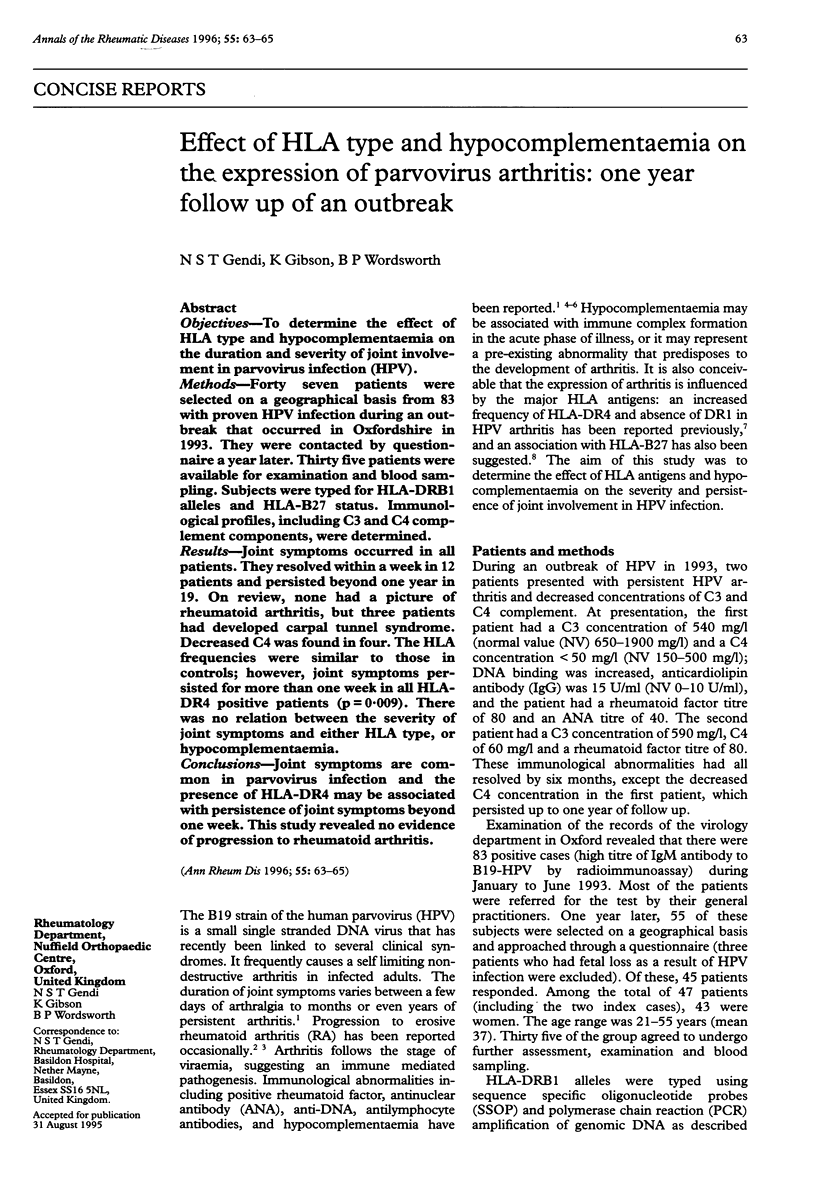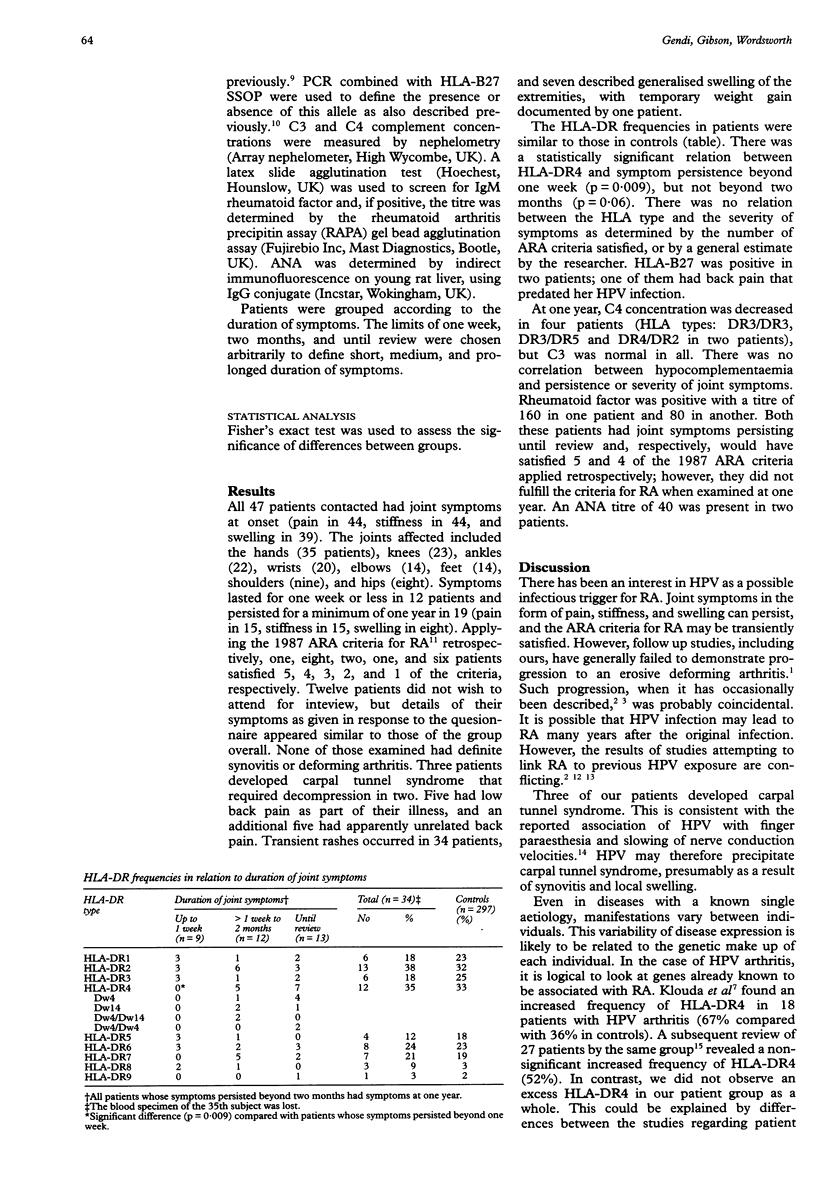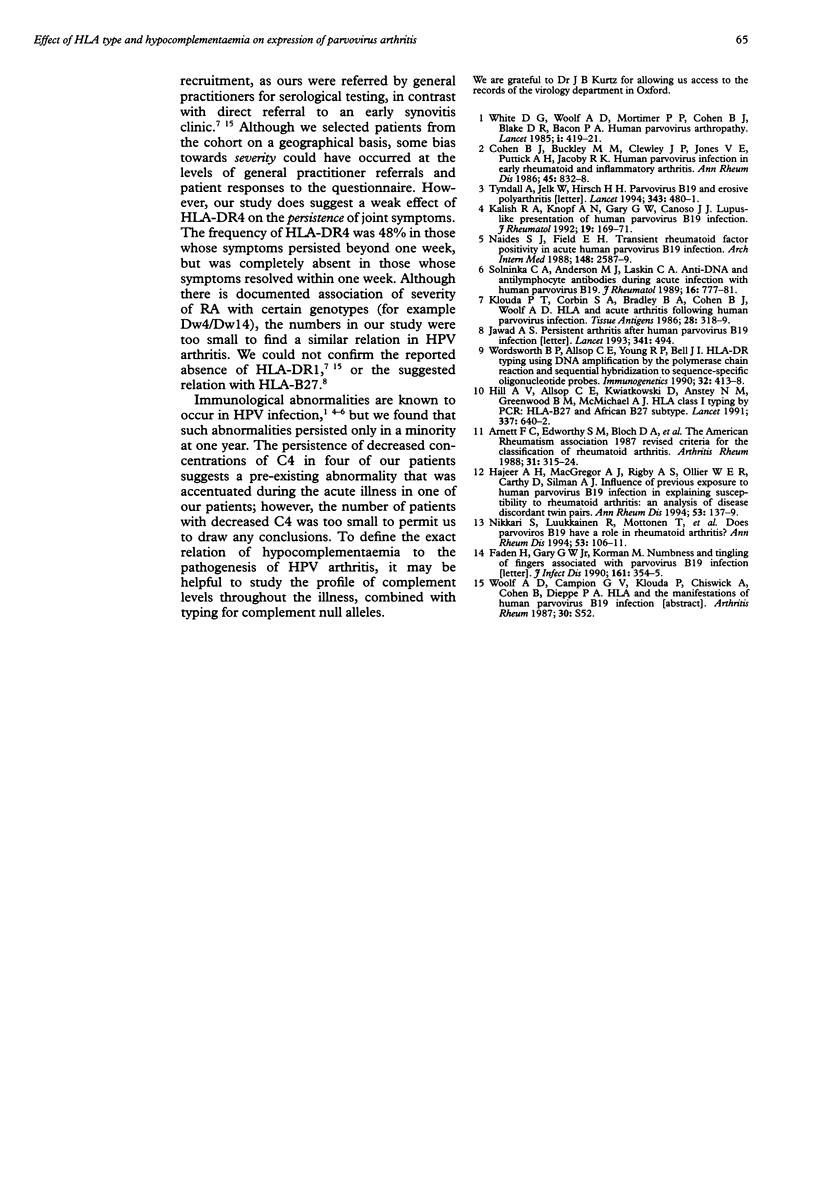Abstract
OBJECTIVES--To determine the effect of HLA type and hypocomplementaemia on the duration and severity of joint involvement in parvovirus infection (HPV). METHODS--Forty seven patients were selected on a geographical basis from 83 with proven HPV infection during an outbreak that occurred in Oxfordshire in 1993. They were contacted by questionnaire a year later. Thirty five patients were available for examination and blood sampling. Subjects were typed for HLA-DRB1 alleles and HLA-B27 status. Immunological profiles, including C3 and C4 complement components, were determined. RESULTS--Joint symptoms occurred in all patients. They resolved within a week in 12 patients and persisted beyond one year in 19. On review, none had a picture of rheumatoid arthritis, but three patients had developed carpal tunnel syndrome. Decreased C4 was found in four. The HLA frequencies were similar to those in controls; however, joint symptoms persisted for more than one week in all HLA-DR4 positive patients (p = 0.009). There was no relation between the severity of joint symptoms and either HLA type, or hypocomplementaemia. CONCLUSIONS--Joint symptoms are common in parvovirus infection and the presence of HLA-DR4 may be associated with persistence of joint symptoms beyond one week. This study revealed no evidence of progression to rheumatoid arthritis.
Full text
PDF


Selected References
These references are in PubMed. This may not be the complete list of references from this article.
- Arnett F. C., Edworthy S. M., Bloch D. A., McShane D. J., Fries J. F., Cooper N. S., Healey L. A., Kaplan S. R., Liang M. H., Luthra H. S. The American Rheumatism Association 1987 revised criteria for the classification of rheumatoid arthritis. Arthritis Rheum. 1988 Mar;31(3):315–324. doi: 10.1002/art.1780310302. [DOI] [PubMed] [Google Scholar]
- Arthritis Health Professions Association. Scientific abstracts. 1986 regional meetings. Arthritis Rheum. 1987 Jan;30(1 Suppl):S52–S72. [PubMed] [Google Scholar]
- Cohen B. J., Buckley M. M., Clewley J. P., Jones V. E., Puttick A. H., Jacoby R. K. Human parvovirus infection in early rheumatoid and inflammatory arthritis. Ann Rheum Dis. 1986 Oct;45(10):832–838. doi: 10.1136/ard.45.10.832. [DOI] [PMC free article] [PubMed] [Google Scholar]
- Hajeer A. H., MacGregor A. J., Rigby A. S., Ollier W. E., Carthy D., Silman A. J. Influence of previous exposure to human parvovirus B19 infection in explaining susceptibility to rheumatoid arthritis: an analysis of disease discordant twin pairs. Ann Rheum Dis. 1994 Feb;53(2):137–139. doi: 10.1136/ard.53.2.137. [DOI] [PMC free article] [PubMed] [Google Scholar]
- Hill A. V., Allsopp C. E., Kwiatkowski D., Anstey N. M., Greenwood B. M., McMichael A. J. HLA class I typing by PCR: HLA-B27 and an African B27 subtype. Lancet. 1991 Mar 16;337(8742):640–642. doi: 10.1016/0140-6736(91)92452-8. [DOI] [PubMed] [Google Scholar]
- Jawad A. S. Persistent arthritis after human parvovirus B19 infection. Lancet. 1993 Feb 20;341(8843):494–494. doi: 10.1016/0140-6736(93)90247-e. [DOI] [PubMed] [Google Scholar]
- Kalish R. A., Knopf A. N., Gary G. W., Canoso J. J. Lupus-like presentation of human parvovirus B19 infection. J Rheumatol. 1992 Jan;19(1):169–171. [PubMed] [Google Scholar]
- Klouda P. T., Corbin S. A., Bradley B. A., Cohen B. J., Woolf A. D. HLA and acute arthritis following human parvovirus infection. Tissue Antigens. 1986 Nov;28(5):318–319. doi: 10.1111/j.1399-0039.1986.tb00502.x. [DOI] [PubMed] [Google Scholar]
- Naides S. J., Field E. H. Transient rheumatoid factor positivity in acute human parvovirus B19 infection. Arch Intern Med. 1988 Dec;148(12):2587–2589. [PubMed] [Google Scholar]
- Nikkari S., Luukkainen R., Möttönen T., Meurman O., Hannonen P., Skurnik M., Toivanen P. Does parvovirus B19 have a role in rheumatoid arthritis? Ann Rheum Dis. 1994 Feb;53(2):106–111. doi: 10.1136/ard.53.2.106. [DOI] [PMC free article] [PubMed] [Google Scholar]
- Soloninka C. A., Anderson M. J., Laskin C. A. Anti-DNA and antilymphocyte antibodies during acute infection with human parvovirus B19. J Rheumatol. 1989 Jun;16(6):777–781. [PubMed] [Google Scholar]
- Tyndall A., Jelk W., Hirsch H. H. Parvovirus B19 and erosive polyarthritis. Lancet. 1994 Feb 19;343(8895):480–481. doi: 10.1016/s0140-6736(94)92725-1. [DOI] [PubMed] [Google Scholar]
- White D. G., Woolf A. D., Mortimer P. P., Cohen B. J., Blake D. R., Bacon P. A. Human parvovirus arthropathy. Lancet. 1985 Feb 23;1(8426):419–421. doi: 10.1016/s0140-6736(85)91145-6. [DOI] [PubMed] [Google Scholar]
- Wordsworth B. P., Allsopp C. E., Young R. P., Bell J. I. HLA-DR typing using DNA amplification by the polymerase chain reaction and sequential hybridization to sequence-specific oligonucleotide probes. Immunogenetics. 1990;32(6):413–418. doi: 10.1007/BF00241635. [DOI] [PubMed] [Google Scholar]


